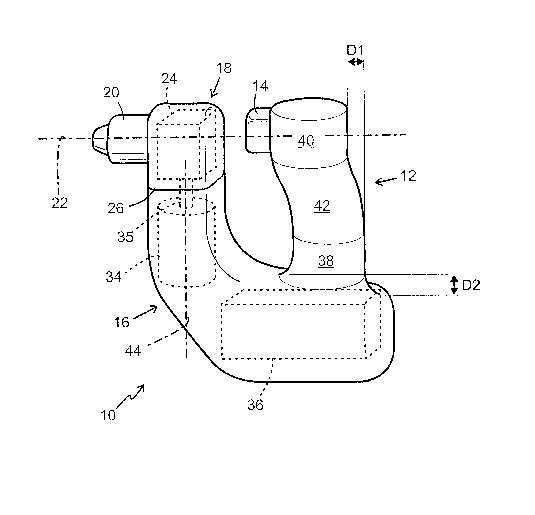Some of the information on this Web page has been provided by external sources. The Government of Canada is not responsible for the accuracy, reliability or currency of the information supplied by external sources. Users wishing to rely upon this information should consult directly with the source of the information. Content provided by external sources is not subject to official languages, privacy and accessibility requirements.
Any discrepancies in the text and image of the Claims and Abstract are due to differing posting times. Text of the Claims and Abstract are posted:
| (12) Patent Application: | (11) CA 2560302 |
|---|---|
| (54) English Title: | POWER TOOL |
| (54) French Title: | OUTIL A MOTEUR |
| Status: | Deemed Abandoned and Beyond the Period of Reinstatement - Pending Response to Notice of Disregarded Communication |
| (51) International Patent Classification (IPC): |
|
|---|---|
| (72) Inventors : |
|
| (73) Owners : |
|
| (71) Applicants : |
|
| (74) Agent: | MLT AIKINS LLP |
| (74) Associate agent: | |
| (45) Issued: | |
| (86) PCT Filing Date: | 2005-03-08 |
| (87) Open to Public Inspection: | 2005-09-29 |
| Examination requested: | 2007-06-29 |
| Availability of licence: | N/A |
| Dedicated to the Public: | N/A |
| (25) Language of filing: | English |
| Patent Cooperation Treaty (PCT): | Yes |
|---|---|
| (86) PCT Filing Number: | PCT/SE2005/000342 |
| (87) International Publication Number: | SE2005000342 |
| (85) National Entry: | 2006-09-19 |
| (30) Application Priority Data: | ||||||
|---|---|---|---|---|---|---|
|
A power tool having a handle (12) and an active portion (18) for engagement
with a work piece. To optimize the engagement forces of the tool and to
provide an open top side allowing for alternative gripping, the handle (12)
and the active portion (18) are joined in a substantially U-shaped
configuration, where the handle and the active portion form free ends at
respective tops thereof, and that the active portion is located such that the
rotational axis lies on a level below said top.
L'invention concerne un outil à moteur comprenant un manche (12) et une partie active (18) destinée à venir en contact avec une pièce à usiner. Afin d'optimiser les forces de contact de l'outil et de mettre en place un côté supérieur ouvert offrant une fixation alternative, le manche (12) et la partie active (18) sont assemblés selon une forme sensible de U, le manche et la partie active formant des extrémités libres au niveau de leur sommet respectif et la partie active étant située de manière que l'axe rotatif se trouve sur un niveau inférieur audit sommet.
Note: Claims are shown in the official language in which they were submitted.
Note: Descriptions are shown in the official language in which they were submitted.

2024-08-01:As part of the Next Generation Patents (NGP) transition, the Canadian Patents Database (CPD) now contains a more detailed Event History, which replicates the Event Log of our new back-office solution.
Please note that "Inactive:" events refers to events no longer in use in our new back-office solution.
For a clearer understanding of the status of the application/patent presented on this page, the site Disclaimer , as well as the definitions for Patent , Event History , Maintenance Fee and Payment History should be consulted.
| Description | Date |
|---|---|
| Time Limit for Reversal Expired | 2009-03-09 |
| Application Not Reinstated by Deadline | 2009-03-09 |
| Deemed Abandoned - Failure to Respond to Maintenance Fee Notice | 2008-03-10 |
| Letter Sent | 2007-08-09 |
| Request for Examination Received | 2007-06-29 |
| Request for Examination Requirements Determined Compliant | 2007-06-29 |
| All Requirements for Examination Determined Compliant | 2007-06-29 |
| Inactive: Cover page published | 2006-11-20 |
| Inactive: Cover page published | 2006-11-16 |
| Inactive: Notice - National entry - No RFE | 2006-11-15 |
| Inactive: Inventor deleted | 2006-11-15 |
| Application Received - PCT | 2006-10-18 |
| National Entry Requirements Determined Compliant | 2006-09-19 |
| National Entry Requirements Determined Compliant | 2006-09-19 |
| Application Published (Open to Public Inspection) | 2005-09-29 |
| Small Entity Declaration Determined Compliant | 2005-03-08 |
| Abandonment Date | Reason | Reinstatement Date |
|---|---|---|
| 2008-03-10 |
The last payment was received on 2007-02-09
Note : If the full payment has not been received on or before the date indicated, a further fee may be required which may be one of the following
Patent fees are adjusted on the 1st of January every year. The amounts above are the current amounts if received by December 31 of the current year.
Please refer to the CIPO
Patent Fees
web page to see all current fee amounts.
| Fee Type | Anniversary Year | Due Date | Paid Date |
|---|---|---|---|
| Basic national fee - small | 2006-09-19 | ||
| MF (application, 2nd anniv.) - small | 02 | 2007-03-08 | 2007-02-09 |
| Request for examination - small | 2007-06-29 |
Note: Records showing the ownership history in alphabetical order.
| Current Owners on Record |
|---|
| CARL RIBBING |
| Past Owners on Record |
|---|
| None |